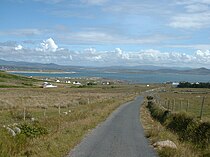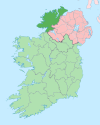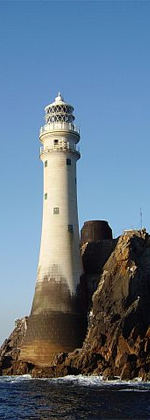Arranmore
This article needs additional citations for verification. (January 2013) |
Árainn Mhór
Arranmore | |
|---|---|
Island | |
 Traditional housing on Arranmore. | |
| Country | Ireland |
| Province | Ulster |
| County | County Donegal |
| Government | |
| • Dáil Éireann | Donegal South–West |
| Area | |
• Total | 22 km2 (8 sq mi) |
| Time zone | UTC+0 (WET) |
| • Summer (DST) | UTC-1 (IST (WEST)) |
| Irish Grid Reference | B665155 |
| Árainn Mhór is the only official name. The anglicized spelling Arranmore has no official status. | |
Arranmore (Template:Lang-ga)[1] is the largest inhabited island of County Donegal, and the second largest in all of Ireland, with a population of 514 in 2011, down from 528 in 2006, 543 in 2002, and over 600 in 1996. The island is part of the Donegal Gaeltacht. The island lies off the west coast of County Donegal, Ireland.
It is also known in English as Aran Island (not to be confused with the Aran Islands off Galway Bay or the Scottish Isle of Arran). In Irish the island was traditionally called Árainn, the adjective mór (large) was added fairly recently. It was also sometimes called in Irish Árainn Uí Dhomhnaill, meaning the 'Aran of the O'Donnells'.
Irish language
There are 529 people living on Aranmore and 62% are native Irish speakers.
Location

The island lies 5 km (3 mi) off Burtonport, a small coastal village in The Rosses, and is served by two ferry services, a conventional ferry that accommodates up to 96 foot passengers and all sizes of vehicles. This journey takes 15 minutes. In 2007, a fast ferry service commenced which can cover the run to the island in 5 minutes. Both services run daily all year. The trip to the island affords spectacular views,[according to whom?] passing a number of small islands before crossing a stretch of open Atlantic water.
Habitation

Most of the population lives along the southern and (comparatively sheltered) eastern coast, where the main village, Leabgarrow (Irish: Leadhb Gharbh), is located. The island has been settled since 'pre-Celtic times', and the few remaining signs of early settlement include a promontory fort to the south of the island and shell middens dotted along the beaches. Its position near the Atlantic shipping lanes was exploited, with a coastguard station and a lighthouse positioned on the most north-westerly point, and a World War 2 monitoring post set up to look out for U-Boats.
The permanent population is 650, but this rises to well over 1,000 during the summer months. A large proportion of the housing stock are holiday homes, with both native islanders and their descendants, as well as non locals, their popularity fueled in part by the scenic nature of the island.
Infrastructure and economy
The island was the first offshore island in the Republic of Ireland to get electricity from the Rural Electrification Scheme, run by the E.S.B., in 1957, but was amongst the last places in the country to get universally reliable piped water (in 1973-75) and an automatic phone exchange (in 1986). It went directly from a manual switchboard to an ISDN-enabled system, which had to be upgraded within weeks due to massive demand for consumer phone lines, as the previous exchange had been limited to issuing numbers to business ventures only, and only had 47 internal lines.

It relies mostly on tourism for its income (fishing was the island's mainstay up to the 1980s but is no longer a significant industry), as well as the traditional Gaeltacht summer schools. In recent years, a local development co-op has encouraged the development of other industries on the island, such as a call centre and teacher training for Irish teachers. The island's many lakes provide rod fishing opportunities.

Arranmore transmitter
The Arranmore Island transmitter is a relay station used by 2RN and Highland Radio to provide coverage to the island and much of The Rosses which are shielded by mountains from the main transmissions. Two towers exist, the smaller of which belongs to Highland, and the significantly larger to 2RN. The EIRP of the stations transmitted by 2RN is amongst the highest of any relay station. The site is 125 m above sea level, with the 2RN antenna standing at 45 metres.
The construction of the 2RN mast in the 1990s was controversial for a number of reasons,[according to whom?] one of them being that the allocated television frequencies (which had been reserved and known for some time) interfered with then-unlicenced relay broadcasts of British television channels in parts of County Donegal.
A 1 kW transmitter, on 104.0 MHz, has been proposed for the i102-104FM radio station which launched in February 2008. Both O2 Ireland and Vodafone Ireland have transmission stations on the 2RN mast.
UHF 45 is allocated to but unused by TV3. 41, 44, 47 and 51 are allocated for Digital terrestrial television.
Other

For a visitor, the island has a character distinct from the rest of County Donegal, partly through its separation from the mainland and partly through its diaspora outside Ireland. The island, in common with many communities at the edge of Europe, has shed people to many parts of the English-speaking world. These are not lost, however, and many return for the summer school holidays, doubling the resident population. The influx of young people during the summer gives rise to an active youth culture.
The result is that a visitor is not conscious of being in the Gaeltacht and soccer (often known locally as football) is preferred to Gaelic games.
The island is 'twinned' with Beaver Island, an island in northern Lake Michigan where a large number of former residents gathered after being evicted from Arranmore in the mid-1800s. There are still today a number of families on Beaver Island that trace their roots to Arranmore.[2]
The island hosts the Arranmore Challenge, an annual soccer competition every June bank holiday weekend where 16 teams compete over 2 days. The competition has increased in popularity every year since it was introduced in 2001, and it hosts teams from all over Ireland and Great Britain.
The Arranmore RNLI Station, with its Severn class lifeboat, is amongst the best equipped in the county.
Places and villages on Arranmore Island
- Aphort
- Plohogue
- Fallagowan
- Ballintra
- Ballard
- Illion
- Leabgarrow (main settlement)
- Leabrannagh
- Pollawaddy
- Scraigatoke
- Torries
See also
References
- ^ As to the meaning of the name, see Deirdre and Laurence Flanagan, Irish Place Names, Gill & Macmillan, 2002.
- ^ http://www.beaverbeacon.com/2003-03-March/The_Way_it_was_The_Arranmore_Connection.html


